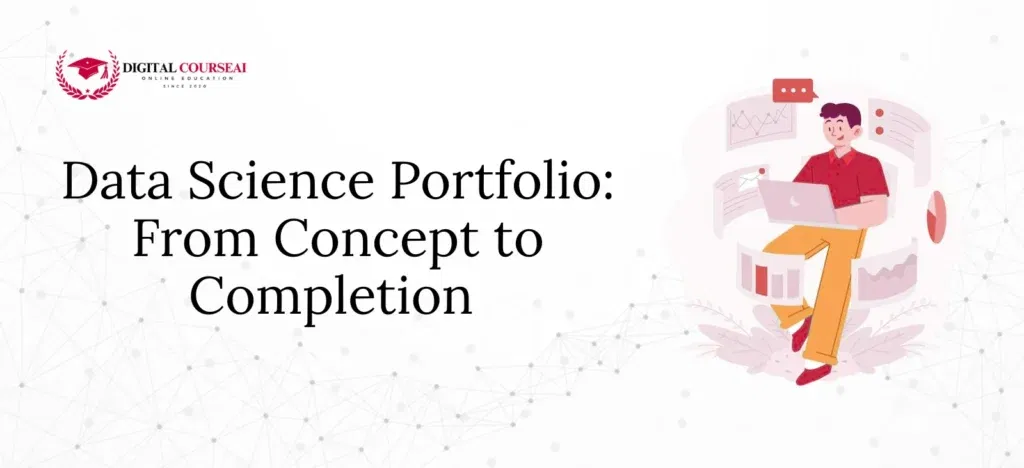Introduction
A data science portfolio is your best asset in getting your next job. You have the opportunity to provide proof of your skills. Not only showing that you can solve problems but also conveying your process and results.
The field is competitive, and to prove you deserve the interview. You must showcase that you can think creatively and have a hunger for data. Also utilise your skills to get to the end of a large—often complex—project.
To address these issues, you should start working on your data science portfolio website. Get ready to learn how to build a data scientist portfolio. That will turn heads with recruiters and hiring managers.
Data Science Portfolio: From Concept to Completion

1) Crafting Unique and Impactful Projects
Projects are the key to any great data science portfolio. To develop great projects, you must focus on creating unique ones. It is hard not to take the bait and use popular datasets, such as the Titanic survival dataset, but you must create unique projects.
A hiring manager has seen the same dozen projects many times over. You want to show at least some creativity, enthusiasm, or a passion for data. However, you are able to take your skills to truly address real-world problems.
Find Your Data:
Somehow find or create open-access datasets through Kaggle, but even better is finding. A problem you are really interested in and searching for the data yourself.
You can use web scraping, using open-access APIs, etc. The more you own the entire process, from data collection to end analysis. The better your portfolio project will be.
Tell a Story:
Every project should have a story. Start with a problem or a question you’d like to answer, and guide the reader through your method. Data cleaning, exploratory data analysis (EDA), model development, and your conclusions.
A good story provides valuable insights into your thought process and problem-solving ability. Both of which matter as much as your technical know-how.
Showcase a Range of Skills:
Do not restrict yourself to a single type of project. An effective data scientist’s portfolio should include a variety of skills, such as
- Data Analysis:
One project that visualises, maps, or plots relevant insights or information they found in a complex dataset. This is a required skill for any data analyst portfolio.
- Machine Learning:
One predictive model (classification or regression) project that solves a problem.
- Data Engineering:
At least one project where the focus was on building a data pipeline or using tools to ingest and/or transform data.
- Business Acumen:
At least one project that demonstrates your insights or model delivers tangible business value.
2) Choosing the Right Platform
The time to centralize the projects that you now have (I recommend three to four projects to begin with) is to showcase them. Your portfolio will not simply be a bunch of Jupiter Notebooks; it will be a professional display of your work.
GitHub:
This is non-negotiable. Every project’s code must be clean, commented, and hosted on your GitHub account. This will serve as the official record of your technical work. Make sure your repos have a proper README.md file that describes the project’s purpose, method, and conclusions.
A Personal Website:
While GitHub is important, a personalized data science portfolio website provides a better experience for recruiters. You can showcase your projects in a manageable way and give a nice, enjoyable experience to them.
Why a Website?
A website allows a hiring manager to read about your projects. See the final results, read your blog posts detailing your process. Also, get an overall sense of your professional identity without having to go through a codebase.
Platform Options:
You do not have to be a web developer to create one. There are good options that are user-friendly.
- GitHub Pages:
This will be free and fully customisable if you have very basic HTML/CSS skills.
- Website Builders:
Wix and Squarespace are straightforward drag-and-drop options. That will allow you to create a professional-looking website with limited effort.
- Medium or Personal Blog:
Write a blog post for each of your projects. This can be a great way to explain your process in a storytelling format. Link these blog posts from your main portfolio site.
3) Structuring Your Portfolio for Impact
How you present your work is at least as important as the work itself. Your data scientist portfolio website will be your personal brand.
The Homepage:
The homepage of your site should be clean and professional-looking. There should be a short section that says “About Me” that describes who you are and what you are passionate about.
This is also the spot to highlight your top 2-3 projects with titles. That describes the project and eye-catching images (e.g., a key data viz or a demo of the project).
Project Pages:
Each project should have its own page. A good project page includes:
- A Catchy Title: Something that attracts the attention of the reader and describes the goal of the project.
- A Problem Statement: A short blurb that summarises the problem you are trying to solve.
- Your Approach: An overview of your approach, at a high level, including method and technology (e.g., Python, Pandas, Scikit-learn, etc.).
- Key Findings: The key findings and insights you obtained and learnt from the project.
- Visuals: Include some charts, graphs, and key images to help communicate your results in a clear, understandable way.
- Links: A prominent link to your GitHub repository for the complete code, and if applicable, A link to a live demo or a link to a blog post that has more details about your project.
The “About” Section:
An opportunity to communicate part of your personality directly to your readers. Discuss your interests, how you arrived in data science, and what you are passionate about. This is important because it makes you relatable and memorable!
Contact Information:
Make it easy for recruiters to reach out to you! Ensure to link to your LinkedIn from and provide your email address.
If you are a top tier educator, having a superior portfolio is the main outcome from attending a top company. For additional portfolio tips and data science strategy, join in the best data science institute in Gurgaon, Digital CourseAI.
4) The Final Polish
Before you show your data science portfolio off to the world, make sure everything is polished.
Proofread Everything: Typos and grammatical errors can make you seem unprofessional. Please review your project pages, blog posts, and about section closely.
Get Feedback: Have a friend or a mentor look over your portfolio. Fresh eyes can catch things you would miss.
Keep it Updated: Your portfolio is a living document. Add new projects as you finish them and always improve on existing projects.
Overall, by focusing on quality rather than quantity, presenting a variety of skills is key. Also, showcasing your work professionally and compellingly. You will build a data science portfolio that presents your technical skills and tells a story of who you are as a professional.
Also Read: NVIDIA Case Study: Digital Marketing, Social Media & Brand Strategy in 2025

